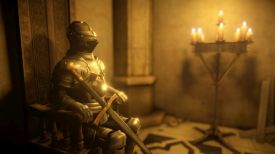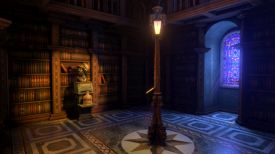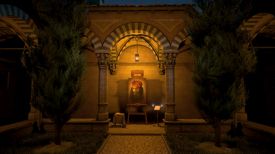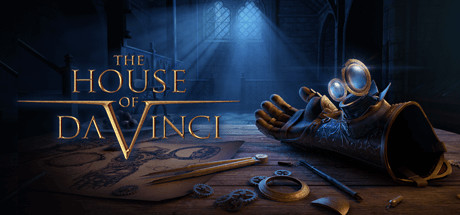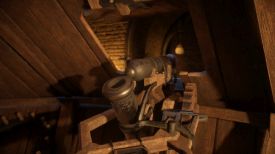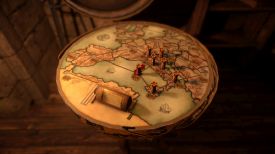|
By flotsam
The House of Da Vinci
Blue Brain Games
Itís Florence in 1506, and the Renaissance is in full swing. Leonardo Da
Vinci has been working on a new machine, one that he says will go beyond
anything he has created to date. He is concerned though about it falling
into the wrong hands, which explains the security he has applied to his
house. But he is confident that you will be able to find your way in,
and he trusts you, which is why the message has arrived, and why you
stand on his doorstep looking for a way in.
What awaits you should you gain access is not Leonardo (he is nowhere to
be found), but a game stuffed full of
puzzles, almost all linked to contraptions and machines. The story (thin
as it is to start with) takes a distinct backseat to the puzzles. Solve
those in one room to gain access to another, and about 10 hours later
reflect on a many and varied, and very satisfying, set of conundrums and
their related gizmos.
If
the interface puts you off, well it did the same for me. Itís fiddly to
say the least, but you will settle in. You probably wonít ever like it,
but (and particularly if you play in decent chunks) the things that
irritate will fade. That the rest of the game is so intriguingly
engaging will help significantly.
While you have to solve everything in one room in order to move to
another, within that room you have freedom to explore and tackle the
various conundrums any way you like. That said, some things require
solving other things first, or doing enough to find a necessary item,
but the room beckons you to explore and prod and pontificate, rather
than fixate immediately on one single thing. I tended to gather
information before flicking or fiddling with anything, but how you go
about it is entirely up to you.
There are no hotspot indicators so in that regard you are on your own.
You will however come to recognise some telltale signs that something
might be done here (I wonít spoil by telling), but you will have to
engage in some unrewarded clicking. If though, something looks like it
could be pulled or unlocked or that it needs something to be inserted,
chances are it does.
The other things you can try are the two lenses Leonardo leaves for you.
The Oculi Infinitum enables you to see things that arenít otherwise
observable, like codes or the brick to press or the object to target.
The Oculi Tempus allows you to look back in time, to perhaps see how
something was able to be solved (did we really need the redundant
pattern tracing involved?). They are worn on a gauntlet but sit to the
right of the game screen and can be activated by a swipe up or down,
depending on which you want. You wonít know when to use one or the other
(or at least I didnít), so be willing to deploy them if you are stuck.
Some puzzles have all you need right in front of you Ė a slider might be
an example. Others require you to have discovered the clues e.g., as to
how to set the various levers to operate the particular machine. A hint
system that is timed (you will have to wait before getting another) can
help (it is a bit hit and miss depending on where you are at), but you
canít skip a puzzle. Whatever the puzzle, it has to be solved. Some
repeat, some are familiar, some might frustrate, but all add to the
tapestry of enjoyment.
As
well as hints, if you have worked your way into a point from which you
can no longer solve a puzzle, near as I could tell it will re-set, and
there was one puzzle I found that I could re-set at will. Exiting the
game also seems to re-set the puzzle you are working on, but I only did
it once so donít count on that. I was encouraged by the apparent fact
that if a puzzle hadnít re-set it could still be solved, regardless of
my fiddling to date, and more than once it spurred me on to greater
efforts.
Visually the game is a treat, and the animations accompanying even the
most mundane of interactions look and sound as they should. The
soundtrack doesnít overwhelm, and gives way to the auditory effects of
exploring and fiddling with things. Animations can be short, or
cinematically and impressively much longer. In that regard, Leonardoís
house is everything you and he might want.
The game plays in the first person and everything is done with the
mouse. Double-click is your stock in trade, to move or to zoom into a
puzzle. Hold the left mouse button and then drag the scene around you to
look about. You can do that too within a puzzle to shift your
perspective. Right click to back out from wherever you are.
Your inventory items sit in a ribbon left of screen. Left click and drag
to use in the game world, right click to examine. The latter can be
important, as numerous items have to be further manipulated to arrive at
their game-worthy configuration. A plus sign on an item in the inventory
means it needs to be combined with another item; right click and then
see whether you have what is required.
You canít save at will, but to the best of my knowledge the game saves
whenever you exit, and you just choose continue from the menu to move
on. Alternatively you can choose to restart the chapter, which coincides
with accessing a new room. Once you finish the game you can re-enter any
room you like, and also access your Ďachievementsí. These are plans you
might have found in the game relating to actual Leonardo inventions,
which are then displayed in a courtyard. From there you can play with
those you discovered.
I
liked this puzzling house a lot.
I
played on:
OS: Windows
10, 64 Bit
Processor:
Intel i7-9700K 3.7GHz
RAM: Corsair
Dominator Platinum RGB DDR4 32GB
Video card:
AMD Radeon RX 580 8192MB
GameBoomers Review Guidelines
August 2023
design copyright© 2023
GameBoomers
Group
 GB
Reviews Index GB
Reviews Index |
